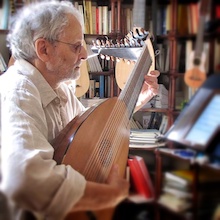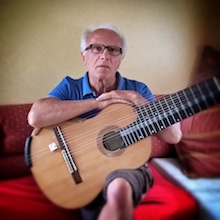Partita in A Major
Fantasia
Tournée
Menuet en Paysanne
Polonoise
Gigue
6 pieces in A Major
Allemande (Par Pichler)
Paysanne (Par Pichler)
Alla Breve
Intrada Andante
Tournée
Menuet
Introductione (Par Pichler)
Allegreza
Alla Breve
Menuet
• Composer(s): Placide Marie Pichler (1725-1796)
• Title: The Haslemere Manuscript
• Sub-title: Pieces and Lute Partitas
• Year of edition: c.1750-1780
• Source: GB-HAdolmetsch Ms II.B.2
• Volume: 3
The Haslemere Manuscript
This manuscript contains tablatures that a lutenist from Dresden or Prague assembled in the second half of the 18th century, most likely to be used for his own playing or teaching. His instrument of reference was a 12-course D-minor-tuned lute. Some pieces require a 13th course, but they are few in number, and the indication of a 13th course may have been added later. This copyist often indicated a composer's name alongside the titles; however, many pieces, whose origin must have been known to him, are anonymous. The tablatures are generally grouped by key, in order to be played consecutively without having to retune the bass courses. Only rarely are these groups of pieces explicitly referred to as Suites or Sonatas.
The original manuscript is now kept at the Carl Dolmetsch Library, in Haslemere, England; its reference is GB-HAdolmetsch ms II.B.2. Its history is unclear; it may have belonged to the Fétis collection, since we know that Fétis sold or traded several of the many works he had purchased1.
In the early 20th century, the manuscript was acquired by Eugène Arnold Dolmetsch (1858-1940). Born French into a family of organ, piano and harmonium makers, Arnold Dolmetsch went to London to study early music and its instruments. He earned a baccalaureate in music in 1889, and settled in London.
Placide Marie Pichler (1725-1796)
Placide Marie Pichler was born in 1725 in Pfaffenhofen an der Ilm, Bavaria. After studying science and music, he entered the Order of Saint Benedict in Thierhaupten in 1741. He was ordained a priest in 1744 and sent to the Scheuern convent, where he was distinguished as one of the best organists of his time. He was probably an excellent lutenist as well, but did not perform in public. He spent several years in Vienna, and travelled to Italy. At the age of 70, he retired to Saint George's Convent in Venice, where he died in 1796.
None of the Benedictine Priest Placide Marie Pichler's music was printed in his lifetime, but, toward 1760, manuscript copies of several of his compositions for small ensembles circulated in Germany. These included six trios for violin, viol and bass, six for luth, violin and cello, and six others for flute, violin and bass. His music for solo lute, clearly in the galant style, can be mainly found in several manuscripts written by contemporary lutenists.
Jean-Daniel Forget | Le Luth Doré ©2015
Partita in A Major
Fantasia
Tournée
Menuet en Paysanne
Polonoise
Gigue
6 pieces in A Major
Allemande (Par Pichler)
Paysanne (Par Pichler)
Alla Breve
Intrada Andante
Tournée
Menuet
• Editor(s): Jean-Daniel Forget & Guy Grangereau
• Music period: Baroque
• Instrument(s): 11c & 13c Baroque lute
• Instrumentation: Baroque lute solo
• Notation: French tablature
• Modern edition: Urtext
• Publisher: Le Luth Doré Urtext Editions
• Year of publication: 2015
• Collection: Lute and Theorbo Music Collection
• Pages: pp. 58
• Dimensions: 230x310 mm
• Weight: 0,320g
• Binding: Section sewn glue binding
• ISMN: 377-0-0017-8814-2

Passionate about the baroque era, Jean-Daniel Forget is a self-taught lutenist. In order to play the forgotten (lute) works of the 17th and 18th centuries, he has copied (and studied) their manuscripts for almost 20 years.
A long career as a computer scientist, having made him expert in programming, allowed him to utilize the normal logic of writing music, especially that which transcribes tablature for instruments with fretted strings.
In collaboration with Guy Grangereau. he has posted his tablatures on a public internet site that is frequented by many lutenists and guitarists.
Forget was enlisted by Miguel Serdoura to help prepare the musical examples for his fine Method of the Baroque Lute. Further on, he continues to assist Serdoura in the preparation of his (lute) editions.

Guy Grangereau is a professional musician who studied guitar playing in Paris, notably with the Brazilian Turibio Santos. Then, he perfected his musical knowledge at Martenot school in Paris.
Since 1984, he gave guitar and piano lessons and, for twenty years, he taught guitar in music schools.
His favorite instrument is a guitar (Maurice Dupont) initially with 13 strings, to which a 14th string was added; more recently were added two strings and a theorbo neck for the last four strings. This 16 strings instrument can be tuned in thirds (open tuning); he uses it to transcribe solo harpsichord works. He also plays a 14-course theorbed baroque lute (Stephen Murphy).
Since 2010, he is collaborating with Jean-Daniel Forget for the copy of German baroque lute manuscripts of the 17th and 18th centuries, in bringing more particularly his musical expertise to the review of the Silvius Leopold Weiss’ work.
Le Luth Doré Urtext Editions
The Le Luth Doré Urtext Editions offer musicians and musicologists worldwide reliable and authoritative musical texts. The main features are:
• superb and aesthetically appealing music engraving
• optimized for practical use (page turns, fingerings)
• books originally in Italian tablature are published in both Italian and French tablatures
• high-quality and durable (cover, paper, binding)
• both original and modern prefaces, documentation of the corrections made and explanatory footnotes in English, French, Italian, German …
About Le Luth Doré Urtext Editions
Our editions are urtext: we strive to provide reliable musical texts that are as true as possible to the existing sources and the composer’s intentions. We are aware, of course, that it is impossible to reconstruct the one and only urtext. Often, several manuscript sources exist for the same piece, and there is little reliable guidance for determining which version best represents the composer's intentions.
Although we cannot entirely dissipate historical uncertainty, we can compare texts and correct obvious errors, which sometimes occur even in autograph manuscripts. Sources have been meticulously examined - note by note, mark by mark.
The most important observations and editorial decisions are elucidated in the prefaces, in the critical commentary, in footnotes, or marked as such in the musical text. It therefore comes as no surprise that an editor has to invest a great deal of patience, knowledge and time when piecing together an urtext that is true to the source and, hopefully, to the composers’ intentions as well. Proven specialists with extensive knowledge and experience edit our Le Luth Doré Urtext Editions in close cooperation with our Editorial Department.
Each verified musical text preserves the original fingerings and notation of ornamentation and, in the absence of original manuscript notations, also sets forth helpful suggestions by modern masters regarding useful fingerings and ornaments faithful to historical style, as a stimulus to further thought and a starting point for the student's approach to performance.
We are deeply grateful to all the extraordinary musicologists, music teachers and artists that put their knowledge and experience at our disposal for Le Luth Doré Urtext Editions.
Le Luth Doré ©2015